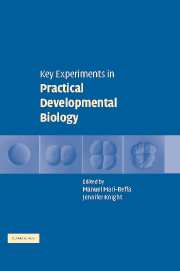Book contents
- Frontmatter
- Contents
- List of contributors
- Preface
- Introduction
- SECTION I GRAFTINGS
- SECTION II SPECIFIC CHEMICAL REAGENTS
- 4 Chemotaxis of aggregating Dictyostelium cells
- 5 Inhibition of signal transduction pathways prevents head regeneration in hydra
- 6 Retinoic acid during limb regeneration
- SECTION III BEAD IMPLANTATION
- SECTION IV NUCLEIC ACID INJECTIONS
- SECTION V GENETIC ANALYSIS
- SECTION VI CLONAL ANALYSIS
- SECTION VII IN SITU HYBRIDIZATION
- SECTION VIII TRANSGENIC ORGANISMS
- SECTION IX VERTEBRATE CLONING
- SECTION X CELL CULTURE
- SECTION XI EVO–DEVO STUDIES
- SECTION XII COMPUTATIONAL MODELLING
- Appendix 1 Abbreviations
- Appendix 2 Suppliers
- Index
- Plate Section
- References
5 - Inhibition of signal transduction pathways prevents head regeneration in hydra
Published online by Cambridge University Press: 11 August 2009
- Frontmatter
- Contents
- List of contributors
- Preface
- Introduction
- SECTION I GRAFTINGS
- SECTION II SPECIFIC CHEMICAL REAGENTS
- 4 Chemotaxis of aggregating Dictyostelium cells
- 5 Inhibition of signal transduction pathways prevents head regeneration in hydra
- 6 Retinoic acid during limb regeneration
- SECTION III BEAD IMPLANTATION
- SECTION IV NUCLEIC ACID INJECTIONS
- SECTION V GENETIC ANALYSIS
- SECTION VI CLONAL ANALYSIS
- SECTION VII IN SITU HYBRIDIZATION
- SECTION VIII TRANSGENIC ORGANISMS
- SECTION IX VERTEBRATE CLONING
- SECTION X CELL CULTURE
- SECTION XI EVO–DEVO STUDIES
- SECTION XII COMPUTATIONAL MODELLING
- Appendix 1 Abbreviations
- Appendix 2 Suppliers
- Index
- Plate Section
- References
Summary
OBJECTIVE OF THE EXPERIMENT Development is the result of the coordinated expression, at the right time and in the right place, of a set of genes. The expression pattern of these mostly regulatory genes depends on the ability of cells to interpret different signals from their neighbors and from their position in the embryo. This chapter presents an easy way to analyze some of the signaling systems typically used by cells to acquire their correct fate. By using well-defined chemicals to selectively block key enzymes in signaling pathways, the normal role of these signaling pathways in hydra development can be determined.
DEGREE OF DIFFICULTY Medium.
INTRODUCTION
Hydra is an evolutionary old metazoan. Its tissue organization is simple, but its cells are determined via a complex pattern of cell–cell interactions. A hydra is essentially a tube consisting of two layers of tissue, the ectoderm and the endoderm, separated by an intermediate layer, the mesoglea. There are two cell lineages, the muscular epithelium and the interstitial stem cells, from which all the cells derive. The adult animal has around 100,000 cells that can be grouped into twelve different tissues. Hydra can reproduce either sexually or asexually. Most significantly, hydra has a high capacity for regeneration and is one of the more complex organisms that is able to regenerate from cell aggregates. These features make hydra an ideal model for studying morphogenesis and differentiation in the adult animal (Gierer, 1974).
- Type
- Chapter
- Information
- Key Experiments in Practical Developmental Biology , pp. 67 - 76Publisher: Cambridge University PressPrint publication year: 2005



